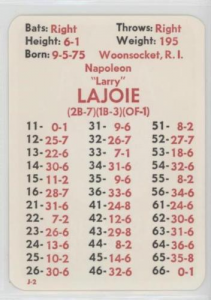Can you imagine the Los Angeles Mikes, or the Washington Bryces, or the Chicago Chriss? How about the New York Babes, or the Detroit Als, or the San Diego Tonys? It’d be strange. However, it wasn’t strange in the early 1900s. From 1903-1915, the Cleveland baseball club was know as the Naps after their star player and manager, Napoleon Lajoie. As you can imagine, you’ve got to be a pretty darn good ball player to have a Major League team named after you. Larry Lajoie was that kind of player.
Nap Lajoie was an oddity for his time. At over six feet tall and about 200 pounds, he was a five-tool player who played the middle infield for most of his career. It was a rarity in the dead ball era to see a player who could hit for power, steal bases, bunt like a magician, throw like a power pitcher, and use his glove like Javier Baez. That is what Napoleon Lajoie was. He wasn’t the typical dead ball era infielder who was all glove and no bat. Lajoie was like a dead ball era Carlos Correa, only better. He was known for his great bat control. Nap could hit to all fields and he was one of the greatest bunters in Big League history.  For a time, he even used a special, double-knob bat.
For a time, he even used a special, double-knob bat.
Lajoie is no stranger to The APBA Blog. His fabulous 1901 season was featured on Monster Card Monday in 2012, and his 1904 season was a Monster Card Monday post earlier this month. Living in our modern baseball world, it’s difficult to appreciate dead ball era APBA cards. Their lack of first column 1s, 5s, and 6s makes them seem inferior to Aaron Judge’s 2017 card. Only if you’ve played a dead ball era replay or tournament can you truly appreciate the greatness of these cards. If you play dozens of games with dead ball era teams, you actually see the power Lajoie had compared to his contemporaries. You learn to appreciate all his zeroes and extra base hits when rolling against countless grade A pitchers.
| I | Split | G | GS | PA | AB | R | H | 2B | 3B | HR | RBI | SB | BB | SO | BA | OBP | SLG | OPS | HBP | SH |
|---|---|---|---|---|---|---|---|---|---|---|---|---|---|---|---|---|---|---|---|---|
| 1916 Totals | 113 | 112 | 455 | 426 | 33 | 105 | 14 | 4 | 2 | 24 | 15 | 14 | 26 | .246 | .272 | .312 | .584 | 1 | 14 |
When I analyzed Lajoie’s final APBA card, I had to make sure it was from 1916 and not 1915. Lajoie only hit .246 in 1916 and I project this card to produce a .282 average, which is similar to his .280 average in 1915. However, the card pictured above has Lajoie listed defensively as a second basemen, first basemen, and outfielder, which matches the positions he played in 1916. Lajoie’s 1915 card should list him as a second basemen, shortstop, first basemen, and third basemen. Nonetheless, APBA was kind to Lajoie with this final card. Though it only has two zeroes, it should be productive, steal some bases, and help produce runs. The production you’d see with this card will come via hits, since it only has a single 14. Lajoie might also reach base a few times via a hit by pitch, since APBA gave him a 22…even though he only got hit by one pitch in 1916. Still, this card seems to have an extra 7. However, when you take into consideration the pitching in 1916, APBA probably figured it was needed for this card to produce accurately. I don’t have the 1916 set, but looking at the statistics, there were at least ten A-starters in the American League alone. They would be: Ruth (BOS) 1.75; Cicotte (CHW) 1.78; Johnson (WSH) 1.90; Coveleski (DET) 1.97; Faber (CHW) 2.02; Cullop (NYY) 2.05; Weilman (SLB) 2.15; Shawkey (NYY), 2.21; Mogridge (NYY) 2.31; and Plank (SLB) 2.33. I feel for Eddie Plank. Can you imagine finishing the 2018 season with a 2.33 ERA and it was only good for tenth in the league? That’s the way it was 102 years ago. Crazy.
Growing up in the 1970s and 1980s, the baseball of my youth was much more similar to the dead ball era than the current game. Most teams bunted and tried to steal bases. Only certain players were considered sluggers and tried to hit the long ball. Larry Lajoie would have fit the era of my youth nicely. Yet, with his size and skill set, he would fit nicely into our current era as well. He might be a cross between Ryne Sandberg and Paul Molitor. I appreciate the current style of Major League Baseball, with tons of home runs, strikeouts, and talk of launch angles and exit velocity. However, there’s something special about small ball. Bunting, moving runners, and stealing bases can be exciting. I can still recall visiting St. Louis in 1988 and loving “Whitey” ball. Vince Coleman, Ozzie Smith, and Willie McGee played a fun, exciting brand of baseball. History has shown us that baseball evolves in cycles. I’m hoping the stolen base and the appreciation of the singles hitter will resurface in the next generation of baseball.





What I didn’t notice originally was that this card has three 31’s for a .240 hitter.
That’s true. I guess that shows his bat control.
Interesting observations. Our 2018 TBL Annual is titled “The New Normal”, and we talk about this and how it’s changed drafting and managing in our league.
Cool. Is there a link to the annual? I’d like to check it out.